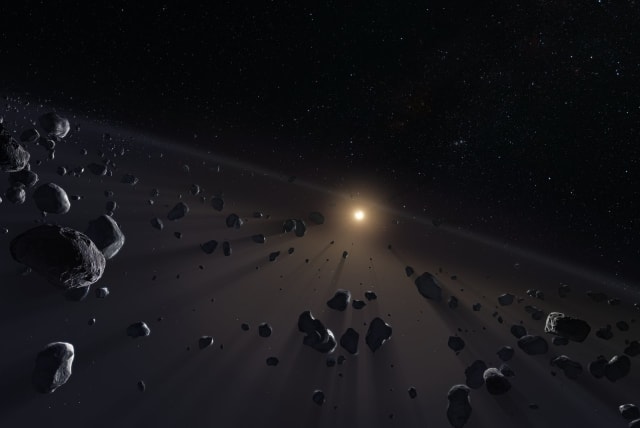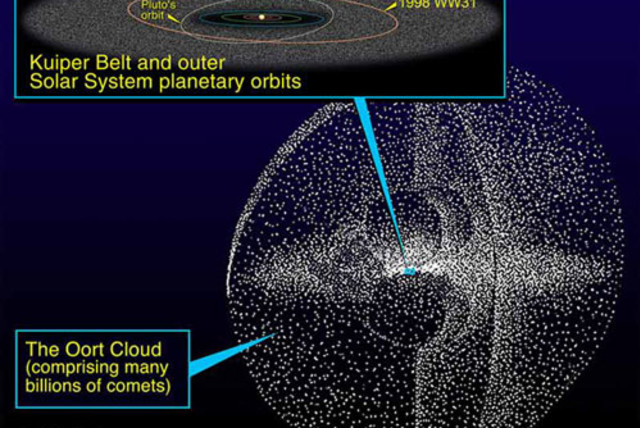An Earth-like planet may be hanging out in the outer solar system - study

A planet about 1.5-3 times as massive as Earth could help explain peculiar properties of the outer solar system.
An Earth-like planet may be hiding in the outer solar system and could help explain some properties of the Kuiper Belt, the ring of icy bodies circling the solar system in the region past Neptune's orbit, Japanese scientists said in a study published last week.
The peer-reviewed study, published in The Astronomical Journal of the American Astronomical Society, examined patterns noticed in "trans-Neptunian objects" (TNOs) - rock and ice bodies remaining from the period of planet formation in our solar system. The study was conducted by scientists from the Kindai University, National Astronomical Observatory of Japan, and Chiba Institute of Technology.
Astronomers estimate that there are millions of small, icy objects in the Kuiper Belt, according to NASA. Hundreds of thousands of the objects are over 60 miles wide and some, like Pluto which sits in the Belt, are over 600 miles wide. (Earth, in comparison, is nearly 8,000 miles wide.)
The mysteries of the Kuiper Belt
Over 1,000 specific objects have been identified in the Kuiper Belt, although the region of space still holds many mysteries. NASA's New Horizons spacecraft is so far the only spacecraft exploring the Kuiper Belt, although the mission is facing the possibility of having its budget cut in the coming year.
The objects in the Belt have a number of odd properties: there appears to be a large number of objects that are not affected by Neptune's gravitational pull, there are many objects that are inclined at an over 45-degree angle compared to the plane of the Solar System, and there are a number of objects with peculiar orbits.
The scientists explained that a planet about 1.5-3 times as massive as Earth, located between 250-500 astronomical units (an astronomical unit is about the distance from the Earth to the Sun, 93 million miles), and inclined 30 degrees compared to the plane of the Solar System.
Such a planet would also help explain the properties of objects that are affected or occasionally affected by Neptune's gravity.
The scientists noted that their theory could be tested by looking for groups of trans-Neptunian objects in areas located over 150 astronomical units away, as the planet they're proposing would create such groupings of objects. The likelihood of detecting or observing the planet would be affected, however, by how big it is and how far away it is.
The scientists added that more detailed knowledge about the orbital structure of the Kuiper Belt will help reveal or rule out the existence of the planet they're hypothesizing. The discovery of such a planet may also affect how we understand planet formation in the area past Jupiter.
The newly proposed planet vs Planet 9
Scientists have repeatedly examined the possibility of a ninth planet (commonly referred to as Planet 9 or Planet X) lurking in the outer solar system, although many studies have assumed that such a planet would be much bigger than Earth.
A preprint study published earlier this year proposed that such a massive planet could be detected by looking for moons that may be circling it, as the moons could be heated by the gravitational pull between the planet and the moons.
The planet has been proposed as a way to explain the behavior of trans-Neptunian objects located very far out in the outer solar system, near the edges or outside of the Kuiper Belt.
The new study published last week noted that while Planet 9 does explain the properties of some much more distant objects in the outer solar system, it does not address the structure of the Kuiper Belt.
Jerusalem Post Store
`; document.getElementById("linkPremium").innerHTML = cont; var divWithLink = document.getElementById("premium-link"); if (divWithLink !== null && divWithLink !== 'undefined') { divWithLink.style.border = "solid 1px #cb0f3e"; divWithLink.style.textAlign = "center"; divWithLink.style.marginBottom = "15px"; divWithLink.style.marginTop = "15px"; divWithLink.style.width = "100%"; divWithLink.style.backgroundColor = "#122952"; divWithLink.style.color = "#ffffff"; divWithLink.style.lineHeight = "1.5"; } } (function (v, i) { });

